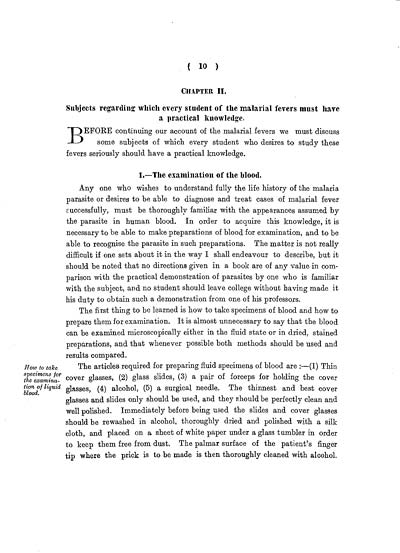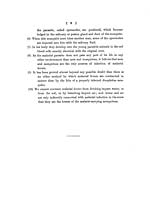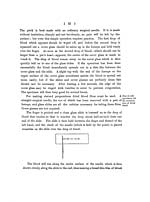Medicine - Disease > Malarial fevers
(16) Page 10
Download files
Individual page:
Thumbnail gallery: Grid view | List view

(10)
CHAPTER II.
Subjects regarding which every student of the malarial fevers must have
a practical knowledge.
BEFORE continuing our account of the malarial fevers we must discuss
some subjects of which every student who desires to study these
fevers seriously should have a practical knowledge.
1.-The examination of the blood,
Any one who wishes to understand fully the life history of the malaria
parasite or desires to be able to diagnose and treat cases of malarial fever
successfully, must be thoroughly familiar with the appearances assumed by
the parasite in human blood. In order to acquire this knowledge, it is
necessary to be able to make preparations of blood for examination, and to be
able to recognise the parasite in such preparations. The matter is not really
difficult if one sets about it in the way I shall endeavour to describe, but it
should be noted that no directions given in a book are of any value in com-
parison with the practical demonstration of parasites by one who is familiar
with the subject, and no student should leave college without having made it
his duty to obtain such a demonstration from one of his professors.
The first thing to be learned is how to take specimens of blood and how to
prepare them for examination. It is almost unnecessary to say that the blood
can be examined microscopically either in the fluid state or in dried, stained
preparations, and that whenever possible both methods should be used and
results compared.
How to take
specimens for
the examina-
tion of liquid
blood.
The articles required for preparing fluid specimens of blood are:-(1) Thin
cover glasses, (2) glass slides, (3) a pair of forceps for holding the cover
glasses, (4) alcohol, (5) a surgical needle. The thinnest and best cover
glasses and slides only should be used, and they should be perfectly clean and
well polished. Immediately before being used the slides and cover glasses
should be rewashed in alcohol, thoroughly dried and polished with a silk
cloth, and placed on a sheet of white paper under a glass tumbler in order
to keep them free from dust. The palmar surface of the patient's finger
tip where the prick is to be made is then thoroughly cleaned with alcohol.
CHAPTER II.
Subjects regarding which every student of the malarial fevers must have
a practical knowledge.
BEFORE continuing our account of the malarial fevers we must discuss
some subjects of which every student who desires to study these
fevers seriously should have a practical knowledge.
1.-The examination of the blood,
Any one who wishes to understand fully the life history of the malaria
parasite or desires to be able to diagnose and treat cases of malarial fever
successfully, must be thoroughly familiar with the appearances assumed by
the parasite in human blood. In order to acquire this knowledge, it is
necessary to be able to make preparations of blood for examination, and to be
able to recognise the parasite in such preparations. The matter is not really
difficult if one sets about it in the way I shall endeavour to describe, but it
should be noted that no directions given in a book are of any value in com-
parison with the practical demonstration of parasites by one who is familiar
with the subject, and no student should leave college without having made it
his duty to obtain such a demonstration from one of his professors.
The first thing to be learned is how to take specimens of blood and how to
prepare them for examination. It is almost unnecessary to say that the blood
can be examined microscopically either in the fluid state or in dried, stained
preparations, and that whenever possible both methods should be used and
results compared.
How to take
specimens for
the examina-
tion of liquid
blood.
The articles required for preparing fluid specimens of blood are:-(1) Thin
cover glasses, (2) glass slides, (3) a pair of forceps for holding the cover
glasses, (4) alcohol, (5) a surgical needle. The thinnest and best cover
glasses and slides only should be used, and they should be perfectly clean and
well polished. Immediately before being used the slides and cover glasses
should be rewashed in alcohol, thoroughly dried and polished with a silk
cloth, and placed on a sheet of white paper under a glass tumbler in order
to keep them free from dust. The palmar surface of the patient's finger
tip where the prick is to be made is then thoroughly cleaned with alcohol.
Set display mode to: Large image | Zoom image | Transcription
Images and transcriptions on this page, including medium image downloads, may be used under the Creative Commons Attribution 4.0 International Licence unless otherwise stated. ![]()
| India Papers > Medicine - Disease > Malarial fevers > (16) Page 10 |
|---|
| Permanent URL | https://digital.nls.uk/74558882 |
|---|---|
| Description | Chapter II.: Subjects regarding which every student of the malarial fevers must have a practical knowledge |




